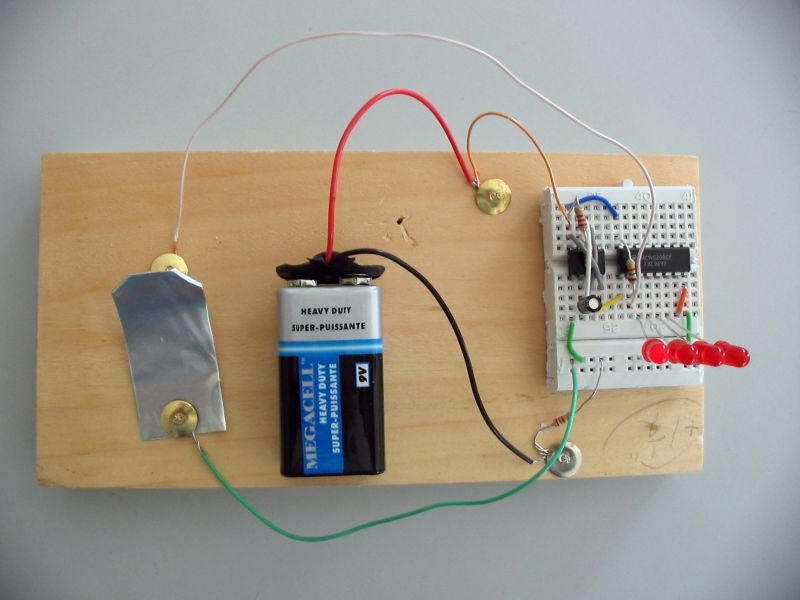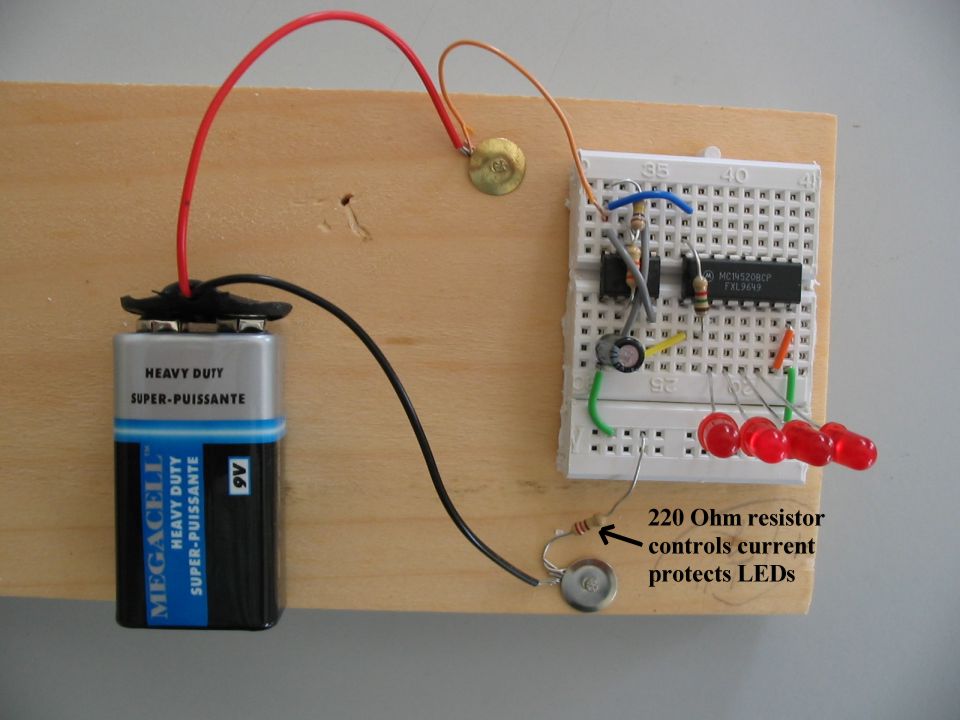Note that your circuit has a 220 Ohm resistor connected between the "-"
(black) wire from your 9 volt battery and your circuit board.
This resistor is important it protects the LEDs from too much current.
If you circuit is not working first of all check to make sure that the metal parts of your battery wire are touching the metal ends of the wires under the thumb tacks.
Next check to make sure that your battery is connected properly. The "+" (red) wire is connected to pin "8" on the 555 (smaller integrated circuit) and the "-" (black)
connects through the resistor to the same row that the LEDs are plugged into.
Test your battery by touching the "+" (red) wire to the "+" side of the LED . Make sure the "-" side of the LED is connected through the resitor to the "-" side of the battery.
If you circuit is still not working carefully check the circuit itself. Check all of your connections. Is the capacitor in the correct way around? Look at the image above and compare it to the circuit you have built. Make sure that the uninsulated (bare metal) parts of wires are not touching each other.
Going Further:
With a simple modification you can turn your circuit into device that works like high tech dice. Rather then throwing dice to create a number you can use your 4520 to create random numbers between 0 and 15.
First change a few components on your circuit to make the 4520 count very fast.
We do this by making the 555 integrated circuit pulse very fast.
Make these changes to the 555 integrated circuit:
Change the 10 uF capacitor to a 1 uF capacitor.
Connect a wire from pin 2 to pin 7 (this replaces the 33000 Ohm resistor with a wire.)
Connect a new resistor from pin 7 to pin 8. Any resistor between 1000 Ohms and 10000 Ohms works.
Now the binary count is so fast that the LEDs appear to be on constantly.
Making a simple switch between pin 2 on the 4520 integrated circuit and the minus side of the battery allows you to freeze the count.
This picture shows one way to make the switch, I used a thumb tack and aluminum foil.

Press the switch and the binary count freezes displaying a number.
Binary numbers:
This resistor is important it protects the LEDs from too much current.
If you circuit is not working first of all check to make sure that the metal parts of your battery wire are touching the metal ends of the wires under the thumb tacks.
Next check to make sure that your battery is connected properly. The "+" (red) wire is connected to pin "8" on the 555 (smaller integrated circuit) and the "-" (black)
connects through the resistor to the same row that the LEDs are plugged into.
Test your battery by touching the "+" (red) wire to the "+" side of the LED . Make sure the "-" side of the LED is connected through the resitor to the "-" side of the battery.
If you circuit is still not working carefully check the circuit itself. Check all of your connections. Is the capacitor in the correct way around? Look at the image above and compare it to the circuit you have built. Make sure that the uninsulated (bare metal) parts of wires are not touching each other.
Going Further:
With a simple modification you can turn your circuit into device that works like high tech dice. Rather then throwing dice to create a number you can use your 4520 to create random numbers between 0 and 15.
First change a few components on your circuit to make the 4520 count very fast.
We do this by making the 555 integrated circuit pulse very fast.
Make these changes to the 555 integrated circuit:
Change the 10 uF capacitor to a 1 uF capacitor.
Connect a wire from pin 2 to pin 7 (this replaces the 33000 Ohm resistor with a wire.)
Connect a new resistor from pin 7 to pin 8. Any resistor between 1000 Ohms and 10000 Ohms works.
Now the binary count is so fast that the LEDs appear to be on constantly.
Making a simple switch between pin 2 on the 4520 integrated circuit and the minus side of the battery allows you to freeze the count.
This picture shows one way to make the switch, I used a thumb tack and aluminum foil.

Press the switch and the binary count freezes displaying a number.
Binary numbers:
Below are the numbers
displayed by your binary counter for 1 to 12.
What would "0" look like?
What would 15 look like?

